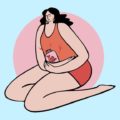
Headaches are a common health problem. Most people experience at some time in their lifetime.
Common headaches types
The most common type of headache is a tension type headache. At least one in three men and half of women suffer from tension type headaches. Tension type headaches are described as a tightening around the head which is often in the front of the head or around the temples. It is present on both sides and is mild to moderate in pain severity. It is commonly associated with stress.
Migraines is a common health condition affecting at least one in seven adults. It is more prevalent in women than in men. Migraines, in women, often start around puberty and improve around the menopause, however they can trouble much younger people including children as young as five. Migraines in women are often hormonally driven. There are various types of migraines however a migraine is typically unilateral in the head i.e. on one side of the head, associated with nausea and vomiting, photophobia (light sensitivity) and phonophobia (sound sensitivity). They are severe in nature and one prefers to lay in a dark room. Migraines are often pulsating or thumping and there are different types. Some people have an aura – usually flashing lights or zig zag patterns before the actual head pain. Others can have weakness in part of their body (very rare) or feel very dizzy together with the other symptoms of migraine. Often women have migraines around the time of their period.
People who suffer from headaches often take over the counter medications or prescribed medication to get rid or improve their headaches. Taking too many medications such as non-steroidal anti-inflammatory drugs or codeine can result in a headache called medication over-use headache. This headache is often described as a dull headache in the front part of the head that is present constantly throughout the day. It will not subside unless the painkiller is stopped. Sometimes people take higher doses of the pain-killers and make the problem even worse.
What can you do to help stop or ease headaches?
Headaches are sometimes caused by habits we develop and simple changes in one lifestyle can improve them. Easy changes include:
- Drink more water
- Cut down the amount of caffeine – do not stop it suddenly as this can result in withdrawal symptoms which include a headache.
- Cut down on the alcohol you drink as alcohol is a known trigger.
- Make sure your eyesight is tested regularly.
- Get plenty of sleep. If you are struggling to sleep, consider using melatonin. This is a hormone which our body secretes and supplementing it may help you sleep better.
- Reduce the amount of time you spend on laptops, tablets and mobile telephones
- Reducing your stress levels
- Do more physical activity. Exercising for 30 minutes 3 times a week have been shown to decrease the headaches by half in patients suffering from recurrent headaches.
- If you have a gas boiler, check that your carbon monoxide detector is working
- Consider taking some vitamins. Some vitamins can prevent headaches. These include magnesium, co-enzyme 10, vitamin D and Vitamin B2 – you can consult your pharmacist or health shop who supply these individually or in combination.
How can I prevent them?
If the above changes have not prevented regular headaches, consider using an over-the-counter medication such as paracetamol or ibuprofen to improve your headache. If you are developing headaches recurrently see your general practitioner to obtain a proper diagnosis and other medications.
When do I need to seek advice?
You should seek doctor’s advice if:
- Over the Counter drugs do not relieve your symptoms
- You are struggling with daily activities or work
- You are vomiting for no apparent reason
- You have high fever, developed a stiff neck or feel drowsy
- If you suffer from persisting headaches after an injury to your head (though a mild headache for 1 to 2 days after a minor head injury is common).
- The headache gets worse on coughing, straining, bending, lying flat or laughing.
- If you develop weakness, or numbness in the face, arms or legs.
- A headache with a painful red eye.
Disability
Headaches are often painful and disabling especially in people who suffer from repeated headache attacks. This obviously causes substantial personal suffering, a poor quality of life and results in multiple sick days due to inability to concentrate and perform ones job. It can affect all parts of life including family, social life as well as employment.
Do you have an experience you’d like to share with us at wham, either in your name or anonymously? Contact us or send us an email at [email protected]

Dr Cherilyn Fenech is engaged as a consultant in Anaesthesia and Pain Management and the Acute Pain Lead at Mater Dei Hospital. Her practice and speciality spans across the full spectrum of pain medicine which includes low back pain, sciatica, neck pain and fibromyalgia. Dr Fenech is also specialised in complex headache disorders and the use of Botox for chronic migraine.
Dr Fenech relocated to central London for a fellowship in chronic pain at Guy’s at St Thomas hospital in 2012. A year later she sat for the World Organization of Pain Fellowship and achieved the highest marks. On achieving this fellowship she became the first Maltese and the first female worldwide to ever be awarded with the distinguished Hassenbusch prize. She became a consultant in Anaesthesia and Pain Management in London in 2014, a role she covered until she returned to Malta in 2018. During that time, she furthered her education in the use of ultrasound and X-rays to treat chronic pain disorders as well as specialized further in treating chronic headache disorders.
Dr Fenech is passionate about improving chronic pain treatment options and is keen to share her knowledge with her colleagues and teach doctors in the health care community. She has also published various papers and posters in chronic pain and headache disorders including writing a chapter in a textbook for chronic pain. She regularly attends international conferences to keep up with any recent developments in her field of expertise.





